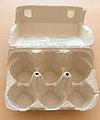|
Living hinge A living hinge or integral hinge is a thin flexible hinge (flexure bearing) made from the same material as the two rigid pieces it connects. DescriptionA living hinge or integral hinge is a thin flexible hinge (flexure bearing). It is made from the same material as the two rigid pieces it connects. It is typically thinned or cut to allow the rigid pieces to bend along the line of the hinge. The minimal friction and very little wear in such a hinge makes it useful in the design of microelectromechanical systems, and the low cost and ease of manufacturing makes them quite common in clamshell containers and other disposable, recyclable packaging.[1] PlasticPlastic living hinges are typically manufactured in an injection molding operation[2][3] that creates all three parts at one time as a single piece, and if correctly designed and constructed, it can remain functional over the life of the part. Thermoforming can also produce hinged products. Polyethylene and polypropylene are considered to be the best resins for living hinges, due to their excellent fatigue resistance.[4][5] Acrylonitrile butadiene styrene (ABS) is also common. [6] Wood A variant on the kerf bend can be used to create living hinges in laser cut wood. The technique is popular for making light-duty hinges with large radii.[7] It is also possible to create a living wood joint by hand, but the result is less accurate.[8] Gallery
See alsoReferences
External links
|
Portal di Ensiklopedia Dunia


